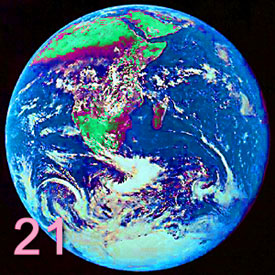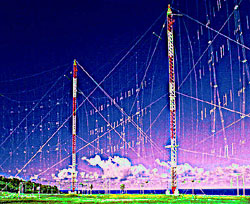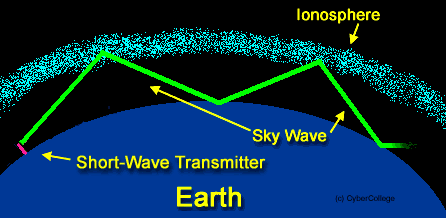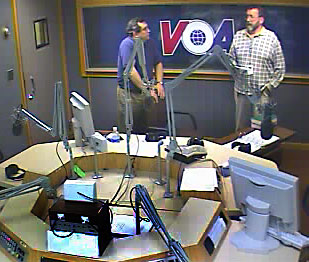|
Film, Radio and TV - 21 |

International Shortwave
Day and night, signals from hundreds of high-powered shortwave transmitters traverse the earth with thousands of programs in more than 100 languages. More than once, this programming has changed the course of world events. Some countries have been so afraid of the information in these shortwave programs that they have spent billions of dollars to jam (electronically block it out) the broadcasts. North Americans, who typically focus only on the AM and FM radio bands, know little about these "battles in the ethers." Even so, a large percentage of the world's population depends on international shortwave for their information. In this module we will not be focusing on hundreds of thousands of relatively low-power amateur transmitters operated by individuals around the world. This type of short wave use, commonly referred to as ham radio, is primarily a point-to-point service and is generally considered a hobby. Even so, ham radio operators are frequently called into service during disasters to relay critical information. Ham radio operators are often the first to tell the world about disasters and medical emergencies. Although these operators use shortwave frequencies, in this module we'll focus on the high-powered, mass media-type, transmitters operated by governments, corporations, and private agencies.
|
|
What Is International Shortwave? Permanent, high-powered shortwave broadcast sites typically involve acres of huge antenna arrays like the one shown here. These sites often depend on miles of wires suspended in the air, as well as miles of buried wire serving as electrical ground systems. Using these arrays, international shortwave stations direct their signals largely toward the ionosphere. Through careful calculations involving electronic directionalizing, power, and atmospheric conditions, these antennas aim their signals so they will come down on specific target areas around the world. From the illustration below you can see how these signals can bounce (refract) off of the ionosphere--even multiple times--and land thousands of miles away. Recall that ionospheric refraction is primarily a nighttime phenomenon.
The transmitting frequencies used for international shortwave are higher than the normal medium wave (MW) frequencies used for standard AM radio. Being higher in frequency, the waves are shorter in wavelength; thus, the term shortwave. Rather than specific frequencies (as in, "this is the 980 spot on your radio dial") international shortwave frequencies first fall into bands (blocks of frequencies). If you want further information on these, Most North American radios do not come equipped with the ability to receive these bands. Fact is, you have to go out of your way to find radios, such as the one on the right, that can tune in the shortwave bands. Shortwave makes for interesting listening. It's easy to tune into stations from all over the world, especially at night. A large percentage of these stations program in English and beam their signals to North America. In addition to news and features about their country, some international stations provide on-air lessons in learning their country's language.
Listening to newscasts from these Communist countries provided (and still provides) some amazing contrasts to the information most of us hear in the free world. Most shortwave services are designed to serve political or religious interests. One that is largely free of this type of "spin" is Britain's BBC World Service. This service broadcasts in 43 languages and is relied upon by people around the world for balanced, comprehensive news. Although the approach might be somewhat dull by U.S. standards, many consider the content to be better balanced and "meatier" than U.S. network newscasts.
If you have Real Audio™ installed in your browser you can In the United States the Voice of America (VOA) One of the studios of VOA is shown on the right. Rather than having the U.S. government disseminating news for its own people--a questionable practice for a democracy--all VOA transmitters are aimed outside of the country. By A version of VOA in VOA broadcasts in the following languages.
From the beginning, there has been an effort to insulate the Voice of America from political pressures. Its news content and balance is carefully evaluated. It was felt that this was the only way that it could maintain credibility around the world. However, in 2004, after a number of rival government-sponsored international broadcast services were started that could bypass this scrutiny, VOA staff members threatened to strike. They felt that if pro-government bias was detected in government -sponsored international broadcast services that the credibility of all U.S. international broadcasting would suffer. Many of the shortwave broadcasters are religious. These are typically evangelical and fundamentalist in nature, and supported by listener contributions. Even so, the largest religious shortwave broadcaster is Vatican Radio, which programs in 40 different languages, makes use of two hundred journalists from 61 countries, and broadcasts into five continents. Pope Pius XI commissioned the inventor of radio, Guglielmo Marconi, to set up the Vatican radio system north of Rome more than 70 years ago. The audio sample links provided above are through the Internet, which generally provides a much better sound than an actual shortwave broadcast.
As we've noted, some countries fear a free flow of information. And, from the perspective of controlling beliefs through controlling information, their fears are justified. The BBC and the VOA have broken major stories that were embarrassing to Communist leaderships before their government agencies could prepare a version for their own broadcasts that was more acceptable to the leadership--although not necessarily true. But, once one truth is out, it's difficult to convince people of "another truth," especially from a government suspected of not being totally truthful to start with. Although it's generally illegal for people in Communist and totalitarian regimes to listen to outside newscasts, many people in these countries have defied these bans, especially in the rural areas that are difficult for the government to monitor. Scores of people in these countries have had shortwave radios hidden under beds, under floorboards, and behind walls. Work slowdowns and drops in morale and productivity have come on the heels of major embarrassing revelations broadcast by such "free world" stations as VOA and the BBC. Defectors from these countries have verified that many of their people relied on these outside newscasts to find out what was really going on in the world. With shortwave signals literally dropping down from the sky, it's difficult to block them out; but billions of dollars have been spent trying. Jamming, or using transmitters on the same frequency, broadcasting such things as recordings of seagulls squawking, heavy machinery running, or just shrill annoying tones, have been common approaches in trying to obliterate outside newscasts and information. Less obvious is just broadcasting "throwaway" programs on the same frequency. (Generally, both programs become unintelligible.) During the cold war the Soviet Union reportedly used 200 transmitting sites throughout Russia using more than 600,000,000 watts of power to jam the transmitters of Radio Free Europe (RFE) the VOA, the BBC World Service, Deutsche Welle, KOL Israel, and Radio Tirana. Additional jamming transmitters were operated by other nations throughout the former Warsaw Pact. According to estimates made by the BBC, almost a billion dollars was spent each year by Russia alone in trying to jam outside broadcasts. The amount of money and effort that went into trying (not always successfully) to block out foreign news and information speaks to the power of shortwave radio--and the fear that some regimes have over a free flow of information. Of course, things are different now in the former Soviet Union. In fact, most of the countries that used to jam outside broadcasts have stopped. The focus has now shifted to trying to block materials from the Internet. Countries that continue to jam outside shortwave broadcast include some African nations, Cuba, China, and some Middle East countries. Sometimes jamming is just reserved for "sensitive" news events. Shortwave broadcasts don't have to rely on the huge antenna arrays pictured above. Lower-power transmitters on boats or in guerrilla hideouts (that regularly shift their locations) are sometimes used to try to destabilize governments. In fact, governments have fallen after shortwave and standard AM, medium wave broadcasts to citizens have been used to coordinate uprisings. During World War II, both sides regularly used secret shortwave transmitters, typically with coded messages, to get reports from, and issue orders to, compatriots behind enemy lines. The broadcast of certain music selections at certain times would be used to communicate information to spies. (Today, secret messages are imbedded into Internet music and photo files in a process called steganography.) Even in the United States there has been fear of clandestine short-wave broadcasts to enemies. In one case during World War II the desert cave where a hermit was living outside of Landers, California was blown up by officials (with him in it) when it was assumed that the radio antenna he was using to get nearby stations in his remote location was some sort of a short-wave transmitter. His radio (they found out later) was only a simple AM radio receiver, and he was just a man who felt he needed to get away from his former turbulent city life. Although telephone, Internet, and satellite signals can be cut or monitored in a nation--and often are--shortwave signals are far more difficult to monitor and control. It's unfortunate that North Americans typically know so little about this powerful international medium. Now, of course, this no longer includes you! In the next module we'll look at commercial radio programming. |
|
To next module To index © 1996 - 2005, All Rights Reserved.
|



 During the "cold war," you could clearly receive stations from the two Communist nations that were broadcasting more hours of shortwave programming than any other country: Russia and China.
During the "cold war," you could clearly receive stations from the two Communist nations that were broadcasting more hours of shortwave programming than any other country: Russia and China. broadcasts in dozens of languages (listed below) from dozens of high-powered transmitters around the world.
broadcasts in dozens of languages (listed below) from dozens of high-powered transmitters around the world.